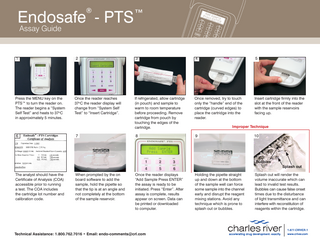Guide
2 Pages

Preview
Page 1
®
Endosafe - PTS™ Assay Guide
1
2
3
4
5
Press the MENU key on the PTS™ to turn the reader on. The reader begins a “System Self Test” and heats to 37oC in approximately 5 minutes.
Once the reader reaches 37oC the reader display will change from “System Self Test” to “Insert Cartridge”.
If refrigerated, allow cartridge (in pouch) and sample to warm to room temperature before proceeding. Remove cartridge from pouch by touching the edges of the cartridge.
Once removed, try to touch only the “handle” end of the cartridge (curved edges) to place the cartridge into the reader.
Insert cartridge firmly into the slot at the front of the reader with the sample reservoirs facing up.
8
9
6
7
Improper Technique
10
Bubbles Splash out The analyst should have the Certificate of Analysis (COA) accessible prior to running a test. The COA includes the cartridge lot number and calibration code.
When prompted by the on board software to add the sample, hold the pipette so that the tip is at an angle and not completely at the bottom of the sample reservoir.
Once the reader displays “Add Sample Press ENTER” the assay is ready to be initiated. Press “Enter”. After assay is complete, results appear on screen. Data can be printed or downloaded to computer.
Technical Assistance: 1.800.762.7016 • Email: [email protected]
Holding the pipette straight up and down at the bottom of the sample well can force some sample into the channel early and disrupt the reagent mixing stations. Avoid any technique which is prone to splash out or bubbles.
Splash out will render the volume inaccurate which can lead to invalid test results. Bubbles can cause false onset times due to the disturbance of light transmittance and can interfere with reconstitution of reagents within the cartridge.
®
Endosafe - PTS™ Assay Guide
********* ENDOSAFE Test Record ********* V7.12A 7/30/2008 DateTime: ... 09/18/08 @ 12:55:42PM Device: ... 0289 OperatorID: ... BCP Cartridge: ... Endotoxin Temperature: .. Start: 37.0C End: 37.0C Method: ... KX-122 Cartridge Lot#: ... 8190159 Cartridge Cal Code: ... 511431494657 Range: ... 5-0.05 Range Time: ... Sec: 114-714 Onset Times: ... >714 248 >714 208 Slope: -0.398 ... Intercept: +2.335 Dilution: ... 100 Sample Lot: ... 99732082 Sample ID: ... 1 Sample Value: ... <5.00 EU/mL Sample Rxn Time CV: ... 0.0% Pass Spike Value: ... 0.828 EU/mL Spike Rxn Time CV: ... 12.4% Pass Spike Recovery: ... 125% Pass Test Suitability: ... Pass
Cartridge sensitivity range Lambda = lowest value (0.05) Reaction time of 4 channels 1 & 3 are sample channels, 2 & 4 are spiked channels Dilution Factor 1 = neat, 10 = 1:10, 100 = 1:100 etc. Reported EU value for sample (factoring in dilution) If sample is non-reactive, EU value = lambda multiplied by dilution factor. CV % of channels 1 & 3 Represents variation in reaction times of the two sample replicates Must be <25% for a valid test result CV % of channels 2 & 4 Represents variation in reaction times of the two spiked replicates Must be <25% for a valid test result Spike Recovery Represents % of spike that was recovered in channels 2 & 4 Must be between 50 and 200% for a valid test result Test Suitability Evaluates sample CV, spike CV, and spike recovery for validity and assigns Pass/Fail grade. “Pass” indicates a valid test and the sample value can be trusted.
Lambda This refers to the lowest concentration in the standard curve; in this example lambda equals 0.05 EU/ml. Spike recovery The spike is an aliquot of test sample together with a known amount of endotoxin. This control serves as a check for interference (inhibition and enhancement). Inhibition and enhancement are conditions that adversely alter the recovery of endotoxin in a test sample. Inhibition is a condition where an LAL test sample decreases LAL reactivity, resulting in endotoxin recovery being less than expected. Enhancement is a condition where an LAL test sample reacts more rapidly than expected, resulting in endotoxin recovery being greater than expected. For a valid assay, the spike recovery value must be between 50 and 200%, thus indicating no significant interference from the test sample.
Technical Assistance: 1.800.762.7016 • Email: [email protected]